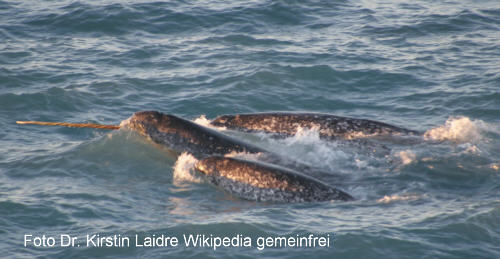Narwhal (Monodon monoceros)

Appearance
The narwhal is a medium-sized toothed whale and a close relative of the beluga whale. Adult males usually reach a length of 4 to 5.5 meters and can weigh between 1,200 and 1,600 kilograms. Females are slightly smaller, averaging 3.5 to 4.5 meters and 800 to 1,200 kilograms in weight. The most distinctive feature of the species is the elongated spiral tusk, which grows from the upper left canine tooth of males and can reach up to 3 meters (10 feet) in length. This tusk contains millions of nerve endings, which makes it a sensitive organ rather than a simple weapon. Most females lack a tusk, although in rare cases they can also develop one.
Distribution
Narwhals inhabit the Arctic waters of Canada, Greenland, and Russia. Their range includes the Canadian Arctic Archipelago, Baffin Bay, Hudson Bay, and the waters off East and West Greenland. They are particularly common in the fjords and inlets of northern Canada and Greenland. Unlike many other whales, narwhals do not migrate into temperate waters, remaining almost exclusively in Arctic regions year-round.
Habitat
Narwhals live in deep coastal waters and areas covered by seasonal sea ice. In summer, they are often found in ice-free fjords and bays, while in winter they remain in areas with dense sea ice, using cracks and small openings in the ice to breathe. They are strongly associated with the continental shelves and slopes of the Arctic Ocean and rely on sea ice for both feeding and protection from predators.
Behavior
Narwhals are social animals that usually live in groups of 10 to 20 individuals, though larger aggregations of several hundred have been observed during migration or in rich feeding grounds. They are capable of diving to depths exceeding 1,500 meters and can remain submerged for up to 25 minutes while foraging. Their vocalizations include clicks, whistles, and knocks, which they use for communication and echolocation. Narwhals are known for their seasonal movements: in summer they gather in coastal bays and fjords, while in winter they move offshore under the pack ice.
Diet
Narwhals primarily feed on fish, squid, and shrimp. Their most important prey species include Greenland halibut, Arctic cod, cuttlefish, and polar shrimp. They use suction feeding to capture prey at great depths, often hunting at 800 to 1,500 meters below the surface. Unlike some other whales, narwhals have no functional teeth in the mouth, and rely on suction and tongue movements to ingest food.
Reproduction
Narwhal mating usually takes place in spring, between March and May, although exact timing varies depending on the region. After a gestation period of about 14 to 15 months, females give birth to a single calf, typically between June and August of the following year. Newborn calves measure around 1.5 meters in length and weigh about 80 kilograms. They are nursed for more than a year, during which they remain closely dependent on their mothers. Females reach sexual maturity at around 6 to 8 years of age, males slightly later at 8 to 10 years.
Threats
Narwhals face a number of threats, primarily from climate change. The rapid decline of Arctic sea ice alters their habitat and feeding patterns. They are also hunted by indigenous communities in Greenland and Canada for meat, tusks, and skin (which is a source of vitamin C). While this hunting is regulated, localized overharvesting can still affect populations. Additional threats include increased shipping and industrial activity in the Arctic, which lead to underwater noise pollution, and the potential risks of oil and gas exploration. The International Union for Conservation of Nature (IUCN) currently lists the narwhal as Near Threatened.
Narwhal Facts – The Unicorn of the Sea
The narwhal (Monodon monoceros) is often called the “unicorn of the sea” because of its long tusk. This tusk can grow up to 3 meters (10 feet) and has thousands of nerve endings, making it a sensory organ rather than just a weapon.
Population and Conservation
According to recent estimates, around 75,000 narwhals live in Arctic waters. The species is listed as Near Threatened on the IUCN Red List due to climate change and hunting pressures.
Interesting Facts
- Narwhals can slow their heartbeat to survive extreme deep dives.
- Females rarely grow long tusks – most tusks belong to males.
- In medieval Europe, narwhal tusks were sold as unicorn horns for enormous prices.
FAQs about Narwhals
Why do narwhals have tusks?
Scientists believe the tusk acts as a sensory organ to detect temperature, pressure, and salinity in the water.
Do all narwhals have tusks?
No, most females do not grow tusks. In rare cases, some males even have two.
